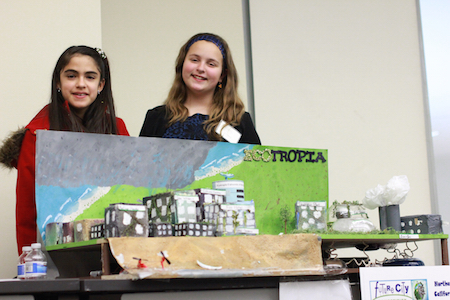Message to Kids: Math Isn’t Monotonous, and Engineering Can Engage

Middle school students Melody Cosgrove and Christina Ramirez were part of the team that built “Ecotropia” for the Future City regional competition hosted by CSU Stanislaus.
Not many people wear their DNA in a necklace. A few cool middle school students now do. The tiny tubes of colored suspension are a perk from taking part in the Winter STEM (Science, Technology, Engineering and Math) Academy that CSU Stanislaus hosted in January.
“I learned that DNA is very long. It extends from the earth to the sun and back several times over,” said Hanshaw Middle School’s Esteban Ramirez, 12. He was one of 30 students bused in from La Loma, Mark Twain, Roosevelt and Hanshaw middle schools in Modesto.
Associate Professor My Lo Ly Thao of the College of Science said, “There isn’t much exposure to the sciences in grade school. If this is one way to do it, I’m in.”
Guided by Thao and student teacher Vasiliki Argyris, students swished saltwater in their mouths, poured it into test tubes, then added detergent to extract DNA from the cells and alcohol to float it. Vibrant food coloring finished the fun take-home project.
In the math module, students pondered parallel and perpendicular lines with math majors Leng Chang and Robert Jimenez, both seniors.
“I want to take away math anxiety,” Chang said. “The challenge is to make sure they learn at least one new thing.”
Bilingual coaches, fluent in Spanish, worked closely with students who needed assistance with technical terms.
“Learners shouldn’t let language be a barrier,” Jimenez said, recalling that as a preschooler he translated for his family. He drew upon his experience in improving language skills.
“I recommend reading. Harry Potter made me want to learn English,” he said.
Besides exploring cells, lab procedures, computer animation, algorithm theory and the intricacy of a geoboard, students also learned about team building, anti-bullying, preparing for college, caring for the environment and improving self-esteem. One day was set aside for the students to present their projects to family members. Capping the week of activities was a field trip to the San Jose Technology Museum of Innovation.
A team of more than 20 members of the campus community produced the Winter STEM Academy. It included faculty members such as Computer Science Associate Professor Megan Thomas, teacher credential candidates, student teachers, and program coordinators Tara Ribeiro and Laura Rodriguez-Mascorro. At the helm was Sundar, who taught one of the math sessions and gave students a daily pep talk.
“It’s important for people to know that beyond our liberal arts offerings, CSU Stanislaus has a strong STEM focus,” Sundar said. “Also, as a Hispanic Serving Institution, it is time we focus on Hispanic youth.”
Summer STEM Academy, the brainchild of Professor of Mathematics Viji Sundar, will launch its 26th year this June. The 2015 winter session is the first of its kind and was funded by a grant of nearly $36,000 from the Migrant Education Program within the Merced County Office of Education.
Winter STEM Academy was a collaboration of CSU Stanislaus Math Grants, the Math and Science Teacher Initiative and the Merced County Office of Education Region III Migrant Education Program. To view a video of activities, go to bit.ly/1E7LZmw. To learn more, contact Professor Viji Sundar at vsundar@csustan.edu.
Another hubbub of campus activity centered on preparing for the Jan. 24 Northern California Regional Finals of the Future City Competition, a national contest that raises engineering appreciation among middle school students. This year’s challenge was to conceive of and build a virtual city with sustainable food sources from agriculture. The local team placed third among 17 at the regional level and fourth among 38 at the state level.
The four students on the team named their imaginative creation “Ecotropia,” having selected a tropical setting. The colorful diorama featured an urban landscape, a two-story domed greenhouse, and innovative ideas to generate power and solve world hunger. The 2-foot by 4-foot miniature metropolis took shape using only recycled materials. The students also co-wrote an essay describing a typical day in Ecotropia.
Marley Ottman, 13, is an 8th grader at Great Valley Academy in Modesto with aspirations to be a nuclear engineer. He said one of his favorite parts of the city was the University of Sciences, which specialized in genetically modified plants that thrive in any climate and produce bigger yields.
Ottman’s teammates were Melody Cosgrove from Salida Middle School, Christina Ramirez from Virginia Parks Elementary in Modesto and alternate Marcos Pimentel from Emilie J. Ross Middle School in Hughson. The team benefited from the mentoring of Sundar; Raul Raya, USDA agricultural engineer with the National Resources Conservation Service; Kevin Testo, a biology teacher from Turlock High School; Robert Baughn, a single subject (chemistry) credential student; and Sienna Samra, a biology major.
“Their eyes are opened to how the real world is run,” said Raya, who has judged the competition for two years and mentored for three. “Most surprising for them is the hard work it takes to build their model. We incorporate math and make sure the scale is realistic. They’re learning all these components they can apply in their classes. They see the different types of engineering involved in making a city function — from building structures and road transportation to water quality— especially with this year’s theme being food production. They all have a good interest in it. They are really bright and catch on quickly. They’ve done the research and know their topic pretty well.”